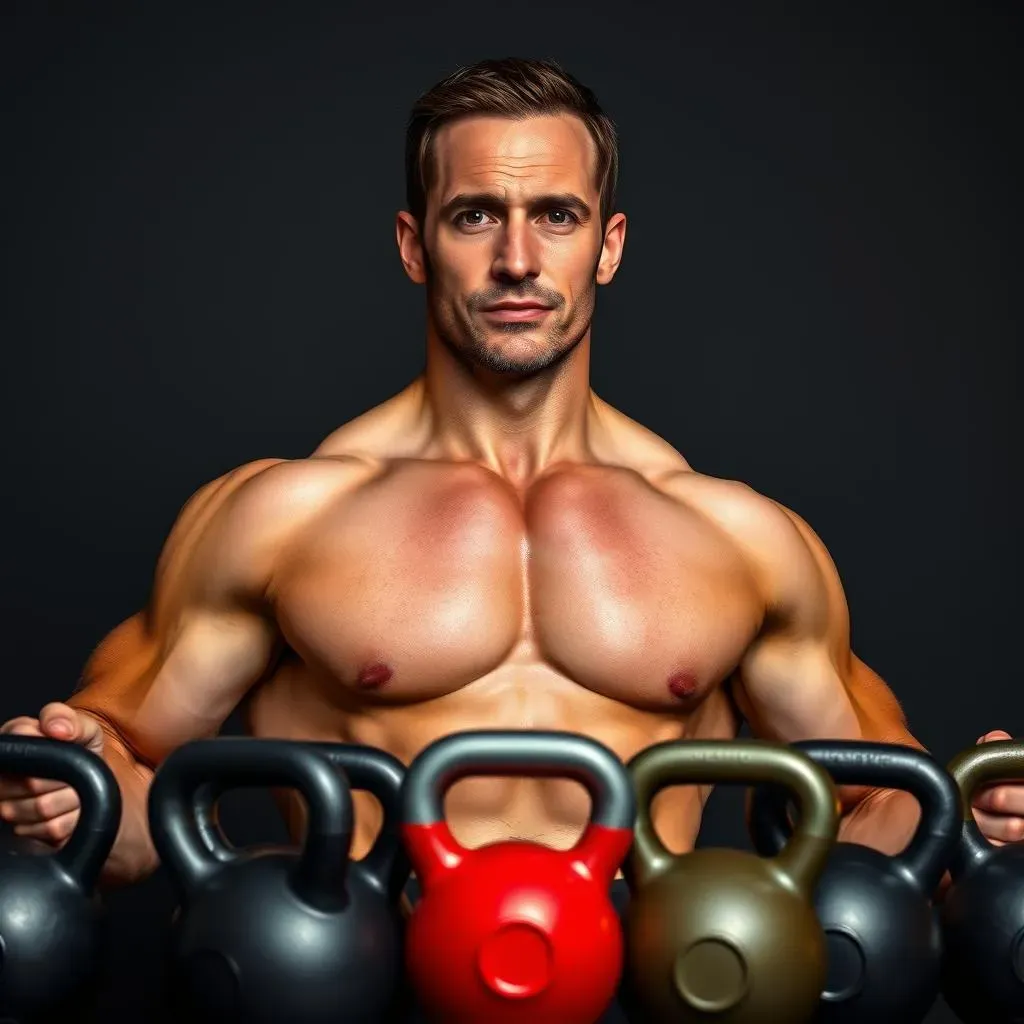Table of Contents
Ever looked at a kettlebell and wondered if it could actually help you build a bigger chest? I did, and let me tell you, it's not just for swings and squats. Forget those boring old bench presses for a minute; we're talking about a dynamic way to sculpt your pecs. This article will show you the best kettlebell chest exercises that are not only effective but also pack a punch when it comes to building strength and size. We're going to break down why kettlebells are a fantastic tool for chest workouts, moving past the usual dumbbells and barbells. I'll guide you through the top exercises, explain how to do them correctly to avoid injury, and give you tips on how to keep progressing so you don't hit a plateau. Ready to ditch the monotony and get some real chest gains? Let's get started with the best kettlebell chest exercises you'll ever try.
Why Kettlebells Are Great for Chest Workouts

Why Kettlebells Are Great for Chest Workouts
Kettlebells: The Unsung Heroes of Chest Training
let's be real, most people think of barbells or dumbbells when they want to build a strong chest. But here's the thing: kettlebells are like the secret weapon you've been missing. Their unique shape and offset center of gravity force your muscles to work harder to stabilize the weight. This isn't just about lifting; it's about controlling the movement. You're not just pushing weight, you are engaging more muscles for each rep. I've seen guys who can bench press a ton struggle with a kettlebell press because of the added stability challenge.
This extra engagement means you're not just working your chest; you're also working your shoulders, core, and even your grip. It’s a full-body party, but your chest is the guest of honor. Plus, they’re just more fun. Who wants to be stuck on a bench all day when you can swing, press, and move in different planes?
Think of it this way: a barbell is like a train on a track, it goes in one direction, up and down. A kettlebell is more like a wild horse, it can move in different directions, and you have to control it. That's what makes it so effective.
More Than Just a Weight
Kettlebells aren't just heavy lumps of metal; they're tools that force your body to adapt. Because of the way the weight is distributed, you get a different kind of muscle activation than you would with a dumbbell. This means you can hit your chest from angles you might not normally reach. I personally experienced this when I switched to kettlebell presses and noticed a deeper muscle engagement.
And let's talk about grip strength. Holding a kettlebell, especially during exercises like flyes or presses, really works your hands and forearms. It’s like a two-for-one deal. You're not only building your chest but also getting a better grip, which helps with other exercises too. This also helps with overall stability, because a strong grip means better control.
It's the kind of training that makes you feel like you are really working, and it pays off. It’s not just about the size of your muscles, but also about how well you can control your body.
Benefit | Description |
|---|---|
Enhanced Stability | Offset weight forces more muscle engagement. |
Full-Body Engagement | Works chest, shoulders, core, and grip. |
Unique Angles | Hits chest muscles in different ways. |
Grip Strength | Improves hand and forearm strength. |
Versatility and Fun
One of the best things about kettlebells is that they're not just for presses. You can use them for flyes, push-ups, and even dynamic movements that build power and explosiveness. I like to mix things up, using kettlebells for some exercises and then switching to bodyweight for others. This variety keeps things interesting and helps avoid overuse injuries.
I've had some of my best workouts just messing around with a kettlebell, discovering new ways to challenge my chest. It's not just about following a rigid plan; it's about having fun and experimenting. The kettlebell is a tool that encourages you to move differently, to think outside the box, and to push your limits.
And that, my friends, is why kettlebells are amazing for chest workouts. They’re not just for the gym; you can use them anywhere, from your living room to the park. So, are you ready to give them a try?
Top Kettlebell Chest Exercises for Strength and Size

Top Kettlebell Chest Exercises for Strength and Size
The Kettlebell Floor Press: Your New Best Friend
Alright, let's get down to business. If you're serious about building a solid chest with kettlebells, the floor press is your go-to move. It's like a bench press, but on the floor, which actually has some cool benefits. For starters, the floor limits your range of motion, which can be easier on your shoulders. I've had a few shoulder tweaks in the past, so this is a big plus for me. It also forces you to really control the kettlebell, making sure you're not just flopping it around.
To do it, lie on your back, hold the kettlebell by the handle, and plant your elbow into the ground. Then, press the weight straight up, focusing on squeezing your chest at the top. It’s not about how much weight you can lift; it’s about how well you can control it. I like to do these slow and controlled, feeling every muscle fiber working. Trust me, you’ll feel the burn, especially if you’re used to just using barbells.
Kettlebell Bench Press: Level Up Your Game
Now, if you have a bench, you can step it up a notch and do a kettlebell bench press. It's similar to the floor press, but you get a greater range of motion, which can lead to more muscle growth. I find that the kettlebell feels different than a dumbbell; it's like it sits in your hand in a way that really activates those chest muscles.
When you do this, make sure your elbows are tucked in a little. This isn't a free-for-all where your elbows flare out. Keeping them tucked protects your shoulders and makes your chest do more work. The key is to lower the kettlebells slowly, feeling the stretch in your chest, and then press back up powerfully. You can use one or two kettlebells, whatever feels comfortable for you. I like to switch between the two, just to keep things interesting.
And remember, it’s not a race. Quality over quantity always.
Exercise | Description | Benefits |
|---|---|---|
Kettlebell Floor Press | Press from the floor. | Shoulder-friendly, great for control. |
Kettlebell Bench Press | Press on a bench. | Greater range of motion, more muscle growth. |
Incline Kettlebell Press: Hit Those Upper Pecs
Don't neglect your upper chest, folks! The incline press is a fantastic exercise to target that area. You can do this with a bench set at an incline, using the same technique as the flat bench press. The incline angle shifts the focus to your upper chest, giving you a more complete chest development. I’ve seen a big difference in my upper chest definition since I added these to my routine.
It's all about that mind-muscle connection, feeling your upper chest working hard with each rep. Don’t just go through the motions. And just like the flat bench press, control is key. Don't let the weight control you; you control the weight.
Remember, consistency is important. It’s better to do a few sets with good form than to do a ton with bad form.
Kettlebell Flyes: Stretching and Squeezing
Now, let’s talk flyes. These are a great way to stretch and squeeze your chest, hitting it from a different angle. Lie on a bench, hold the kettlebells with a slight bend in your elbows, and lower them out to the sides, feeling that stretch. Then, bring them back up, squeezing your chest at the top. It’s like giving your chest a big hug.
The trick here is to keep your elbows slightly bent and not to go too heavy. It’s easy to get carried away, but you want to focus on feeling the stretch and contraction in your chest, not just lifting the weight. I sometimes like to use lighter weights and focus on really squeezing my chest at the top of the movement. It's not about how heavy you can lift, but how well you can control the movement.
It's a great way to finish your chest workout.
Deficit Push-Ups with Kettlebells: A Different Challenge
Finally, let’s not forget about push-ups. You can make them more challenging by using kettlebells as handles, which creates a deficit. This allows you to go deeper into the push-up, giving your chest a greater range of motion. Place the kettlebells on the floor, grip them, and do a push-up, going as low as you can while maintaining good form.
This is a great way to add some variety to your push-ups and really challenge your chest. I find that it also works my shoulders and triceps a little more. It's a great bodyweight exercise, but with a little added challenge.
So, there you have it. These are some of the best kettlebell exercises you can do to build a strong and defined chest. Remember, it's not just about lifting heavy; it's about lifting smart.
"The key to success is not just about the weight you lift, but the way you lift it." - Someone who lifts
How to Perform Kettlebell Chest Exercises Safely and Effectively

How to Perform Kettlebell Chest Exercises Safely and Effectively
Grip It Right
so you're ready to start throwing kettlebells around, right? Not so fast. Before you even think about pressing that weight, let's talk about the grip. It's not just about grabbing the handle; it's about how you hold it. You want to make sure the handle is resting in the meaty part of your palm, not up in your fingers. This gives you better control and helps you avoid wrist strain. I've seen people trying to grip it like a baseball bat, and let me tell you, it doesn't end well.
Also, think about your hand insertion. When you pick up the kettlebell, your hand should be inserted through the handle properly. It should be deep enough to give you a solid grip but not so deep that it feels awkward. It’s like shaking someone’s hand; you don’t want a weak handshake, but you also don’t want to crush their hand. It's a similar thing with the kettlebell. Get the grip right, and you're already halfway there.
Start Light, Go Slow
I know, I know, you want to lift all the weights right now, but trust me on this one: start light and go slow. It’s way better to master the movement with a lighter weight than to try to go heavy and end up hurting yourself. Think of it like learning a new dance; you wouldn't start with the most complicated moves, would you? You’d start with the basics, getting the steps right first. Same thing with kettlebells.
Focus on the form, on controlling the kettlebell, on feeling the muscles working. Don’t worry about how much weight you’re lifting; worry about how well you’re lifting it. I've been there, trying to lift too heavy too soon, and it never ends well. It’s not a race, it’s a journey. So, start with a weight that feels comfortable, and slowly increase it as you get stronger.
And remember, if it hurts, stop. Pain is your body telling you something’s not right, so listen to it.
Safety Tip | Description |
|---|---|
Proper Grip | Hold the handle in the meaty part of your palm, not your fingers. |
Hand Insertion | Make sure your hand is properly inserted through the handle for a solid grip. |
Start Light | Begin with a lighter weight to master the movement. |
Go Slow | Focus on controlling the kettlebell, not just lifting it. |
Progressing Your Kettlebell Chest Workout for Best Results

Progressing Your Kettlebell Chest Workout for Best Results
The Magic of Progressive Overload
so you've got the basics down, you're pressing and flying like a pro, but now what? Well, my friend, it's time to talk about progressive overload. This is where you gradually increase the demands on your muscles over time. It’s not about just throwing more weight around; it’s about making your muscles work harder each workout. Think of it like leveling up in a video game. You don't stay at level one forever, do you? You keep challenging yourself to get stronger.
There are a few ways you can do this. You can increase the weight, do more reps, or add more sets. You could also try decreasing your rest time between sets, which makes your workout more intense. The key is to keep pushing yourself, but not so hard that you hurt yourself. It's a delicate balance, kind of like walking a tightrope. I like to keep a workout journal to track my progress and make sure I’m not just spinning my wheels.
Double Progression: A Smart Approach
Now, let's get a little bit more advanced with something called double progression. This is where you increase the reps first, before increasing the weight. Let's say you're doing kettlebell presses with 20 pounds and you can get 8 reps in a set. Instead of jumping straight to 25 pounds, you would first try to get 10, 11, or even 12 reps with the 20-pound kettlebell. Once you can comfortably hit your target rep range, then you can increase the weight.
This approach is great because it allows you to gradually build strength and muscle, without rushing into heavier weights too soon. It's all about mastering the movement and feeling in control. I’ve found this method to be super effective, and it helps to prevent those frustrating plateaus. It's like building a house; you need a solid foundation before you can start adding floors.
And remember, consistency is key. It’s better to progress slowly and steadily than to go too fast and get injured.
Progression Method | Description |
|---|---|
Increase Weight | Gradually lift heavier kettlebells. |
Increase Reps | Perform more repetitions with the same weight. |
Increase Sets | Add more sets of each exercise. |
Decrease Rest Time | Reduce rest between sets for added intensity. |
Listen to Your Body
This is a big one, folks. While it’s important to push yourself, it's equally important to listen to your body. If you’re feeling tired or sore, it’s okay to take a rest day. It’s not about being a hero; it’s about being smart. I’ve learned this the hard way, pushing myself too hard and ending up with injuries that set me back weeks.
Rest and recovery are just as important as the workouts themselves. Your muscles don’t grow when you’re lifting; they grow when you’re resting. So, make sure you’re getting enough sleep, eating well, and taking those rest days when you need them. It’s not about how hard you can go; it’s about how consistently you can go.
"The body achieves what the mind believes." - Someone who is wise
Mix It Up
Don't be afraid to mix things up! Variety is the spice of life, and it’s also the spice of a good workout routine. You don't want to keep doing the same exercises over and over. Your body will adapt, and you'll stop seeing results. Try different variations of the exercises we talked about, or even try some new ones.
You can also change your rep ranges, your sets, and your rest times. The idea is to keep your body guessing, so it doesn’t get too comfortable. I like to switch things up every few weeks just to keep things interesting and to challenge my muscles in different ways.
So, there you have it. These are some tips to help you progress your kettlebell chest workouts. Remember, it’s a marathon, not a sprint. Be patient, be consistent, and have fun with it!
"Progress is not always linear. There will be good days and bad days. Just keep showing up." - A wise person
Wrapping Up: Your Kettlebell Chest Journey
So, there you have it—a solid roadmap to building a powerful chest with kettlebells. We’ve covered the reasons why kettlebells are awesome for chest work, explored some of the best exercises, and discussed how to perform them safely and effectively. Remember, it's not just about throwing around heavy iron; it's about control, technique, and consistent effort. Don’t be afraid to experiment, push your limits, and most importantly, listen to your body. With patience and dedication, you'll not only see improvements in your chest but also in your overall strength and stability. Now, go grab those kettlebells and make those gains.